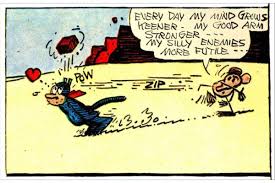In my 3rd year of college, psasidhar, then in final year, was The guy in the CSE department. He had the right contacts, an unshakeable reputation, and consequently, unlimited access to the (extremely slow) College Internet Line. He didn’t abuse this power, no sir. Except for the short time when he diverted all outgoing mails to trash while his script to download the complete Calvin and Hobbes strips from a site ran on the server and ate up the complete bandwidth, and I would hardly call that abuse.There were other such scripts, of course, the most notable one being a script that downloaded a CD-load of Windowmaker themes. I hardly used Linux even then, except for finishing weekly assignments, and that was a rare occurrence anyways. But Sasi’s themes forced me to use Window-maker, if only for to check out the cool wallpapers that came bundled with them.

I happened to watch Ghost in the Shell recently, after years of reading about its greatness, and about the influence it has had on mainstream movies like The Matrix, and the influences it has borrowed from cyberpunk traditions ( William Gibson, Bladerunner). I was not disappointed. Stylish without being overtly violent, with genuine “Oh-my-god” moments. As usual, it was the road to the movie that was more memorable. I got the comics from a Bandwidth-rich junior, then the soundtrack album a year later when I got my connection at home. Then the soundtrack to the sequel Ghost in the Shell 2: Innocence. Followed by the soundtrack of the TV series. Then found the DVD of Innocence, a version with terrible subtitles, in The Market. Then, a couple of weeks ago, the movie.
The soundtrack of the movie deserves a seperate post in itself. Kenji Kawai, the composer, uses a striking theme for the opening, called “The Making of Cyborg”, which is a choral piece in Japanese, backed with booming taiko drums and chimes. The chorus is hypnotic – I am left wondering which parts of it is synthetic and which parts sung by real people. “Ghost City” and “Reincarnation” play on variants of the same choral-drum theme. The second track is like just a bass drum playing a single beat, slow, evocative.
Ghost in the Shell 2: Innocence, also by Kawai has almost the same soundscape, with minor differences in tone and intensity. Brilliant, is all I have to say. So are the soundtracks to the TV series, which are composed by Yoko Kanno, the lady best known for her Cowboy Bebop compositions. As expected, these are tracks that cannot be slotted into a single genre, a single track might hop from a Big-band orchestral arrangement to spanish guitar music and then, as you are gasping for breath, move into heavy metal mode.
Trivia:
1) The title “Ghost in the Shell” comes from Arthur Koestler’s book The Ghost in the Machine, which also lends its name to an album by The Police. Koestler himself borrowed the term from a British philosopher named Gilbert Ryle who coined it to refute the Descartian ( or is that Cartesian) principle of seperation of mind and matter.
2) The US dubbed version of the movie had a track called “One Minute Warning”, with music by Brian Eno and U2. While this is nowhere to be seen on the official soundtrack album, I found it on a CD called Passengers, at a sale in Hyderabad. This was even before I got the manga.
Ironic Nostalgia Moment of the Day: This post, dated May 2003, where I mentioned the shock value associated with discovering a DVD of Ghost in the Shell at Music World. I did find it in Music World two years later. (not the genuine Music World, this is the shopping centre at Basheer Bagh that shares the same name) Now is that prophetic or what?
P.S: Some of Sasi’s wallpapers are now part of RECian legend – they were used (without any form of acknowledgement whatsoever) as backgrounds for the brochure of Trivium 2001, our very own Quiz Fest. Not the GITS one, much to my regret.
